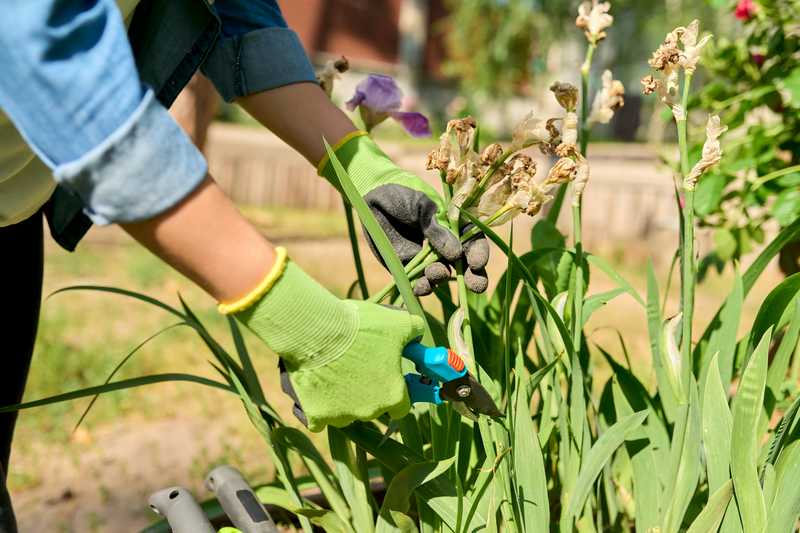
Easy to grow, irises ( Iris germanica ) are essential in the garden! To make them bloom well, they must be planted in the sun, in well-drained, clean soil and leave sufficient space between each plant. With this article, discover how to care for irises after flowering and all year round .
Tips for having beautiful irises
To avoid a large number of problems and diseases of the irises, their location must be chosen carefully. Garden irises ( Iris germanica ) ideally appreciate dry, calcareous and stony soil, and a situation in full sun.
To cultivate them without problems in heavy and clay soils:
- Add sand when planting to improve drainage.
- Set up the rhizomes flat, in all directions, and on a small mound of earth so that the water does not stagnate and flows more quickly.
- The rhizome of the iris must be flush with the surface of the earth: you can even leave 1/3 of its upper part protruding in the open air. Too buried, it rots more easily!

If the growing conditions do not seem to be suitable for your irises, do not hesitate to move them to a more suitable place, always in full sun, such as at the foot of a wall of the house .
Leave enough space between the feet and divide them in the summer every 3 or 4 years.
Cleaning irises after flowering
Remove faded flowers from your irises as you go. This simple gesture prevents the formation of seeds and that the clumps become exhausted to bear fruit.
This cleaning also helps keep tufts clean and decorative.
Cut each wilted iris flower at the base without touching the surrounding leaves.
Remember to disinfect your shears with a little alcohol before and after this size to avoid transmitting diseases.

Should the leaves of the irises be cut? Wait until winter is over before completely clearing the clumps of leaves from your irises. The rest of the year, just remove or shorten diseased leaves very regularly, without ever cutting all the leaves.
Weed between iris clumps
Irises like open ground at their base. It is therefore necessary to weed regularly to avoid letting unwanted weeds develop.
You can use a smiley as long as you don’t get too close to the irises. Indeed, if you injure a rhizome or a superficial root, the risk of disease and the appearance of rot increases.
Between the clumps, the best weeding is therefore that carried out by hand !
To avoid having to weed too often at the foot of your perennials, it is generally advisable to spread a mulch. This advice is not suitable for irises because the mulch retains moisture, which promotes crown rot disease but also the proliferation of slugs.
How to water the irises?
With garden irises, you save water because they are very sober plants. Just water them only at planting time , then once every 15 days until you see signs of recovery.
Later, in maintenance, the rule is simple: Never water them ! The irises do not need our water supply, except during a long period of drought or a heat wave in the summer.
Also be careful not to plant your irises with flowering perennials that need frequent watering! Instead, pair them with plants that hate humidity like lavender or poppies .
Automatic watering by sprinkling started on the lawn or in a bed of perennials, for example, can do great damage. Irises hate it!
Do Irises Need Fertilizer?
In general, fertilizers are useless for irises : they are satisfied with the nutrients found in the soil.
Nevertheless, in sandy soils or really very poor in humus, you can give a little compost throughout flowering or an organic fertilizer rich in phosphorus such as bone meal, guano, or ashes. Instead, make this contribution after the end of flowering.
Above all, avoid giving a fertilizer rich in nitrogen because it promotes leaf growth, not flowering!
Monitor diseases and slugs
If you grow your irises in good soil and exposure conditions, disease is rare .
Watch for the appearance of iris rust. The leaves turn yellow and then dry up in areas or completely. This disease appears especially during a wet period, especially when the summer is rainy. You can cut the most affected parts of the leaves with garden scissors in order to clean the clumps.
In wet weather, watch out for slugs and snails: they can do a lot of damage! They leave characteristic holes in leaves and can eat flower buds before they open.
